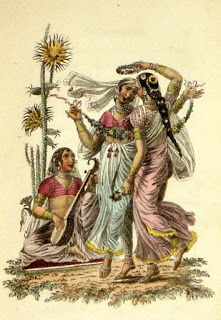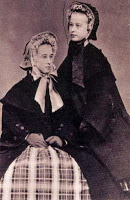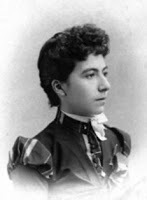The Divine and the Disrespected
 Back in 2013, I wrote a series of posts on women in history. It began with “Women of Steel” and continued through “Taking the Veil,” with a brief follow-up in “The Kremlin Beauty Pageant.” That last post looks at marriage politics, a crucial feature of my Legends of the Five Directions novels—indeed, one of the reasons for the existence of that series, as the Muscovite elite’s use of marriage politics has become generally accepted within my field but remains largely unknown outside it. (For the other posts, start with “Taking the Veil,” and you can follow them back, one by one.)
Back in 2013, I wrote a series of posts on women in history. It began with “Women of Steel” and continued through “Taking the Veil,” with a brief follow-up in “The Kremlin Beauty Pageant.” That last post looks at marriage politics, a crucial feature of my Legends of the Five Directions novels—indeed, one of the reasons for the existence of that series, as the Muscovite elite’s use of marriage politics has become generally accepted within my field but remains largely unknown outside it. (For the other posts, start with “Taking the Veil,” and you can follow them back, one by one.)Ancient history, you may think, both literally and figuratively. But when I wrote about Anjali Mitter Duva’s Faint Promise of Rain , followed in short order by Mary Doria Russell’s Doc and Epitaph, I realized I had left out one major path by which women found their own way in the world when other means failed them: the option of servicing men without marriage. There is a reason why prostitution is called “the world’s oldest profession”: it’s been around since the time of Sumer, at least, and began under circumstances not unlike those described in Faint Promise of Rain. Even the Old Testament mentions it.
Nevertheless, the world that Adhira enters in Faint Promise of Rain is quite different from Doria Russell’s Wild West. Adhira becomes a devadasi, a temple dancer (in an unexpected coincidence, the Western term for a devadasi is bayadere, as in the ballet that forms the backdrop to my Kingdom of the Shades—more on that soon). The devadasis are married to the god to whom their temple is dedicated. At the same time, powerful male patrons pay for their support, and the devadasis are required to satisfy their patrons’ sexual demands. As a result, these women are simultaneously revered for their connection with the divine and victimized. When the British arrive on the scene, with their Victorian sensibilities, they cannot see the difference between the temple dancers and the “loose” women they left behind in London, and the dancers’ status quickly declines.

One might say that it declines to the level of the saloon girls in the Wild West, so richly portrayed in Doc and Epitaph. But their situation, too, turns out to be more complex than it first appears. Kate Harony, Doc Holliday’s long-time if inconstant lover, and Josie Marcus, who married (or did she?) Wyatt Earp, both spent time in the brothels of Dodge City, Tombstone, and elsewhere. Josie’s stint in prostitution was short, but she lived with one Tombstone politician before taking up with Wyatt Earp, who was living with another woman at the time. Kate practiced the oldest profession for decades, including during her relationship with Doc, before marrying someone else after Doc’s death. She had little choice, despite speaking numerous languages and possessing a classical education; when she was orphaned at fifteen, she had no other means of support. Yet Josie and Kate and the other Earp women moved in and out of the sex trade, alternating with periods as common-law wives and mistresses and sometimes legal spouses.
 This is the seamy side of women’s history, long brushed under the rug except for the royal favorites who enliven any history of medieval and early modern Europe. But Kate’s story shows why we ignore it at our peril. For so much of history, women have depended on husbands and fathers for their support. Prevented from acquiring professional skills, often forbidden to work except in certain low-paid and low-status occupations, and despised for using what they have, should they be so unlucky or so unwise as to fall out of the socially approved nest, they have done whatever they could to make ends meet. There was no state-supported social welfare program, so the alternative was the poor house— if it existed, which it did not in the Wild West—or starvation. Alms from churches and monasteries did little to offset the reality of poverty and in any case ceased after the Reformation to be a significant source of aid.
This is the seamy side of women’s history, long brushed under the rug except for the royal favorites who enliven any history of medieval and early modern Europe. But Kate’s story shows why we ignore it at our peril. For so much of history, women have depended on husbands and fathers for their support. Prevented from acquiring professional skills, often forbidden to work except in certain low-paid and low-status occupations, and despised for using what they have, should they be so unlucky or so unwise as to fall out of the socially approved nest, they have done whatever they could to make ends meet. There was no state-supported social welfare program, so the alternative was the poor house— if it existed, which it did not in the Wild West—or starvation. Alms from churches and monasteries did little to offset the reality of poverty and in any case ceased after the Reformation to be a significant source of aid. Yet society’s condemnation was harsh. The “whores” who trailed in the wake of the early modern European armies were, for the most part, women who remained faithful to one soldier—who washed his clothes, prepared his food, bore his children, and fought for his interests—but who lacked a wedding ring or a church record confirming their relationship. We are fortunate to live in a time and place when our options, if not infinite, are much greater than our foremothers’. Let us not forget how difficult a woman’s life can be, even today.
All images from Wikimedia Commons. Friedrich Schoberl’s drawing of the devadasis (1820s) and the photographs of Kate Harony at fifteen with her sister (Kate is the one seated, ca. 1867) and Josie Marcus at twenty (1881, taken in Tombstone by C. S. Fly) are in the public domain in the United States because they were produced before 1923.
Published on March 11, 2016 07:52
No comments have been added yet.



